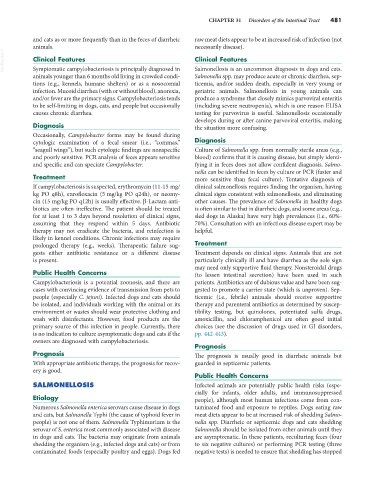Page 509 - Small Animal Internal Medicine, 6th Edition
P. 509
CHAPTER 31 Disorders of the Intestinal Tract 481
and cats as or more frequently than in the feces of diarrheic raw meat diets appear to be at increased risk of infection (not
animals. necessarily disease).
VetBooks.ir Clinical Features Clinical Features
Symptomatic campylobacteriosis is principally diagnosed in
Salmonella spp. may produce acute or chronic diarrhea, sep-
animals younger than 6 months old living in crowded condi- Salmonellosis is an uncommon diagnosis in dogs and cats.
tions (e.g., kennels, humane shelters) or as a nosocomial ticemia, and/or sudden death, especially in very young or
infection. Mucoid diarrhea (with or without blood), anorexia, geriatric animals. Salmonellosis in young animals can
and/or fever are the primary signs. Campylobacteriosis tends produce a syndrome that closely mimics parvoviral enteritis
to be self-limiting in dogs, cats, and people but occasionally (including severe neutropenia), which is one reason ELISA
causes chronic diarrhea. testing for parvovirus is useful. Salmonellosis occasionally
develops during or after canine parvoviral enteritis, making
Diagnosis the situation more confusing.
Occasionally, Campylobacter forms may be found during
cytologic examination of a fecal smear (i.e., “commas,” Diagnosis
“seagull wings”), but such cytologic findings are nonspecific Culture of Salmonella spp. from normally sterile areas (e.g.,
and poorly sensitive. PCR analysis of feces appears sensitive blood) confirms that it is causing disease, but simply identi-
and specific and can speciate Campylobacter. fying it in feces does not allow confident diagnosis. Salmo-
nella can be identified in feces by culture or PCR (faster and
Treatment more sensitive than fecal culture). Tentative diagnosis of
If campylobacteriosis is suspected, erythromycin (11-15 mg/ clinical salmonellosis requires finding the organism, having
kg PO q8h), enrofloxacin (5 mg/kg PO q24h), or neomy- clinical signs consistent with salmonellosis, and eliminating
cin (15 mg/kg PO q12h) is usually effective. β-Lactam anti- other causes. The prevalence of Salmonella in healthy dogs
biotics are often ineffective. The patient should be treated is often similar to that in diarrheic dogs, and some areas (e.g.,
for at least 1 to 3 days beyond resolution of clinical signs, sled dogs in Alaska) have very high prevalences (i.e., 60%-
assuming that they respond within 5 days. Antibiotic 70%). Consultation with an infectious disease expert may be
therapy may not eradicate the bacteria, and reinfection is helpful.
likely in kennel conditions. Chronic infections may require
prolonged therapy (e.g., weeks). Therapeutic failure sug- Treatment
gests either antibiotic resistance or a different disease Treatment depends on clinical signs. Animals that are not
is present. particularly clinically ill and have diarrhea as the sole sign
may need only supportive fluid therapy. Nonsteroidal drugs
Public Health Concerns (to lessen intestinal secretion) have been used in such
Campylobacteriosis is a potential zoonosis, and there are patients. Antibiotics are of dubious value and have been sug-
cases with convincing evidence of transmission from pets to gested to promote a carrier state (which is unproven). Sep-
people (especially C. jejuni). Infected dogs and cats should ticemic (i.e., febrile) animals should receive supportive
be isolated, and individuals working with the animal or its therapy and parenteral antibiotics as determined by suscep-
environment or wastes should wear protective clothing and tibility testing, but quinolones, potentiated sulfa drugs,
wash with disinfectants. However, food products are the amoxicillin, and chloramphenicol are often good initial
primary source of this infection in people. Currently, there choices (see the discussion of drugs used in GI disorders,
is no indication to culture asymptomatic dogs and cats if the pp. 442-443).
owners are diagnosed with campylobacteriosis.
Prognosis
Prognosis The prognosis is usually good in diarrheic animals but
With appropriate antibiotic therapy, the prognosis for recov- guarded in septicemic patients.
ery is good.
Public Health Concerns
SALMONELLOSIS Infected animals are potentially public health risks (espe-
cially for infants, older adults, and immunosuppressed
Etiology people), although most human infections come from con-
Numerous Salmonella enterica serovars cause disease in dogs taminated food and exposure to reptiles. Dogs eating raw
and cats, but Salmonella Typhi (the cause of typhoid fever in meat diets appear to be at increased risk of shedding Salmo-
people) is not one of them. Salmonella Typhimurium is the nella spp. Diarrheic or septicemic dogs and cats shedding
serovar of S. enterica most commonly associated with disease Salmonella should be isolated from other animals until they
in dogs and cats. The bacteria may originate from animals are asymptomatic. In these patients, reculturing feces (four
shedding the organism (e.g., infected dogs and cats) or from to six negative cultures) or performing PCR testing (three
contaminated foods (especially poultry and eggs). Dogs fed negative tests) is needed to ensure that shedding has stopped

